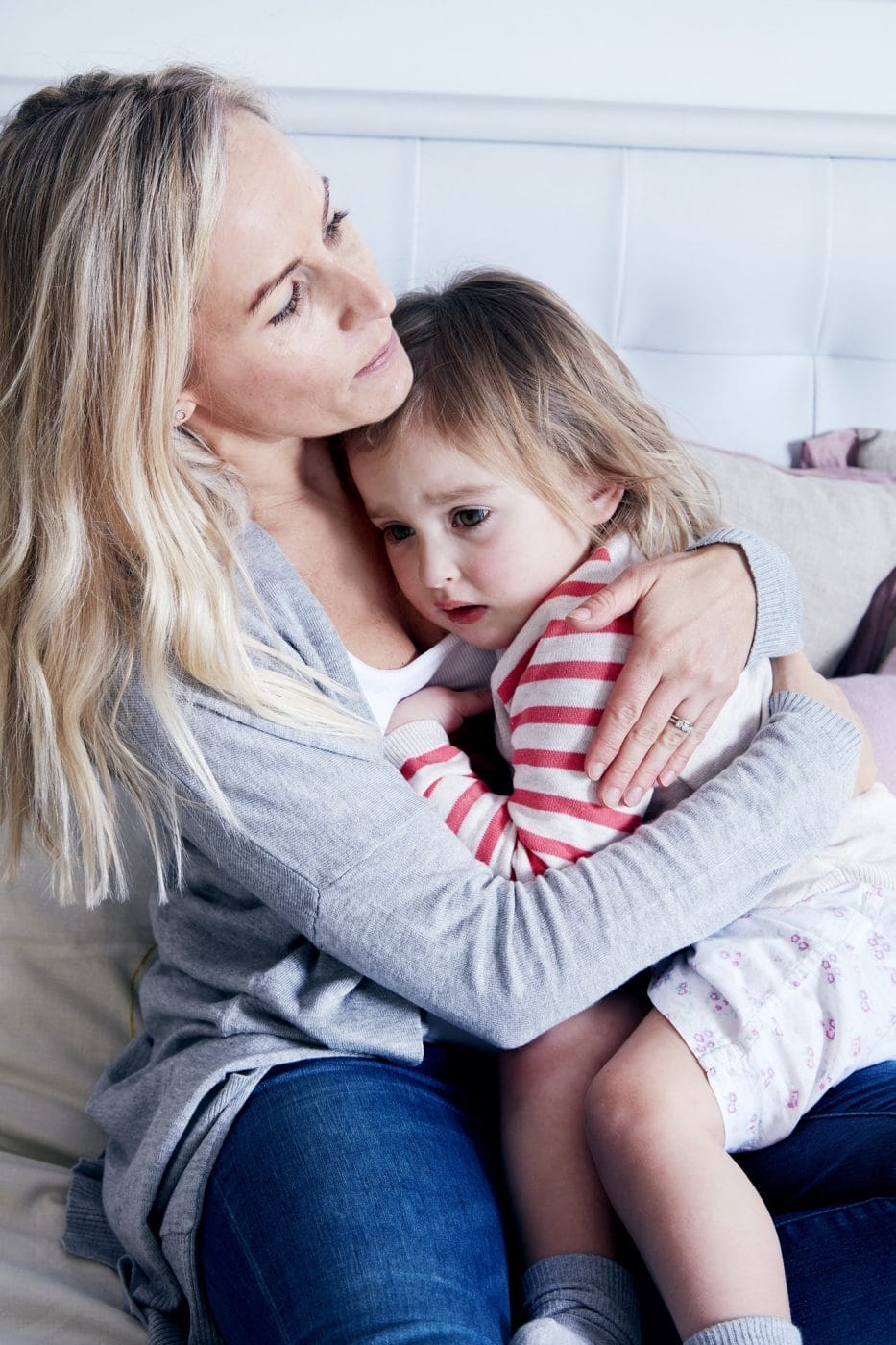Yelling at your child happens—what you do *after* is what counts, mama

If we don't do anything about the guilt it can eat away at us.
Table of Contents
Most parents out there have lost their cool in front of their child at least once. It happens. And it’s not too hard to find people or resources out there providing reassuring statements like, “It’s okay, it happens to everyone,” or “Don’t worry, everyone makes mistakes,” or some other variation of that.
I agree with those statements completely and have even found myself offering those words of support to friends at times. But most of the time, when we are the ones who messed up, those statements don’t really take away the guilt we feel, do they?
I’m sure there are entire books out there about parent guilt because it’s plentiful and comes in many forms. But the guilt I’m talking about today is a little different than the guilt we feel when we are too busy cooking dinner to play, or the guilt we feel when we have to leave a child with a caregiver in order to go to work, or the guilt we feel when our child is crying and we can’t figure out what’s wrong.
In those situations I just mentioned, guilt comes underserved. We haven’t done anything wrong, but we still feel bad. That guilt is more like a version of heartbreak. Because we are limited as human beings and cannot give more of ourselves than what we have.
But the guilt that we feel when we lose our cool is different. That guilt is worthy of the name—we did do something wrong, and we feel bad about it. That guilt is indicative of our own morality. It’s a sign that we can acknowledge our mistakes and our poor decisions.
It’s a good, healthy thing to be able to feel guilt when it’s warranted. But it certainly doesn’t feel good. In fact, if we don’t do anything about that guilt it can eat away at us.
So what can we do after we’ve lost our cool with our child? It takes three steps:
Step 1: Calm down
If you’re still in the hot zone, you’re not going to be able to use the part of your brain that helps you make thoughtful, rational decisions. So you’ve got to get yourself out of that hot zone. This can be one of the biggest challenges as a parent, especially if you’re a single parent or a stay-at-home parent or someone who doesn’t have a partner that can take over so you can take a break.
Sometimes you might need to find ways to take a mental break even when you can’t take a physical break. This is where you’re going to need some creativity, and it will all depend on the age of your children.
It might be packing the kids up into the stroller and going for a walk outside. Maybe you keep special activities aside for moments like these when you need to entertain the kids and catch a breath. Perhaps this is a moment you become a little more lax with your TV restrictions. If your kids are old enough, you can even tell them you need to take a break to calm down and go in another room for a bit.
However you do it, finding a way to calm down is necessary to move on.
Step 2: Allow your child to calm down
In the same way that you’re not able to be thoughtful or rational when you’re upset, neither can your child. If your child is still in that feeling, you will also need to help them find a way to calm down. (After you calm yourself down first!). They will be unable to have a corrective experience otherwise.
Helping your child to calm down will look different depending on their age:
- The littlest ones might need to be held, rocked or played with.
- Toddlers and preschool-aged children might need help to label their feelings, or to cry, or to direct their anger in an appropriate way (ex: your brother isn’t for hitting, but you can hit this pillow).
- School-aged kids may still need help to label their feelings and could also find drawing their feelings helpful. Physical exercise and alone time might be beneficial for these kids too.
- Teenagers are most likely to need time away from you to calm down. Music, art, poetry and writing are all effective mechanisms for releasing emotions to calm down. And physical activity can help release the physiological energy that builds up when angry.
Step 3: Repair
This is where the good stuff happens. Repair is all about taking the bad feelings that have just happened and releasing them through forgiveness and love. When we don’t repair after conflict occurs, kids and parents are left with those negative feelings stuffed inside. Over time, those negative feelings accumulate and eventually explode.
In addition to a feelings explosion, parent-child conflict has a long-term impact on children’s internalization of the process of conflict. As with most things, kids learn about the conflict through their parents.
They learn about the “rules” of conflict
- Is it okay to yell?
- Is it okay to name call?
- Is it okay to throw things?
- Is it okay to give the silent treatment?
They learn about themselves
- Am I bad? Or did I just do something wrong?
- Am I a burden? Or does my value outweigh my challenges?
- Am I still loved even when I make a mistake?
And they learn about the ability to work through conflict
- Do relationships end after conflict occurs?
- Is forgiveness possible?
- Can you be mad at someone and still love them?
As you can see, the way children experience conflict with their parents sets the stage for a lot of significant beliefs and expectations later on. So being able to effectively repair the break in the relationship after conflict occurs is incredibly important!
How to repair your relationship after conflict:
1. Determine that both you and your child are calm
Make sure you’ve completed steps one and two above. You both need to be able to reconnect with the rational part of your brain that can think things through and have a dialogue.
2. Approach your child and invite them to talk
This doesn’t have to be a formal invitation necessarily, but by thinking of this as an invitation, it reminds you that your child has the ability to decline.
Perhaps you misjudged, and they are still angry and not ready to move on to the repair stage yet. Or maybe they are busy doing something else, and this isn’t a good time. This step is all about demonstrating respect for your child.
3. Offer affection
You can adapt the level of affection to what you’re comfortable with and what you are accustomed to using with your child. But affection is powerful. It has the ability to melt away negative feelings instantaneously when offered genuinely. And can set up your conversation out of a place of love instead of anger or guilt.
4. Apologize
This step is important! Some parents think apologizing undermines their authority, but remember what I said above about parent-child conflict shaping your child’s experience with conflict going forward?
Do you want your child to demonstrate accountability for their actions? Do you want them to communicate this accountability to others? Do you want them to apologize to you for their misbehaviors?
If you answered yes to any of those questions, then you need to start by demonstrating the behavior you want your child to learn. And that means apologizing to your child when you make a mistake. Being able to apologize for your mistakes is indeed a sign of strength, and you want your child to gain that strength.
5. Encourage your child to express their feelings
In order to fully move past this issue, you’ll need to allow your child the opportunity to express how they felt when you did whatever you did. This will help him to release any remaining negative emotions stuffed inside and ensure that this isn’t something that’s going to come boiling over later down the line. So take a deep breath and listen.
6. Validate your child’s emotion
Whatever emotion your child brings up, find a way to communicate that their feeling is understandable. It doesn’t matter if you wouldn’t have felt the same way your child felt. All that matters is that your actions made your child have some negative feelings, and now it’s your job to help them feel okay about those emotions.
If you do these steps, you and your child will both walk away feeling lighter and more relaxed. If either of you doesn’t feel that way, something may have been off. Were you both calm when the conversation happened? Was your apology genuine? Did your child express the feelings he had inside? You can always go back and try the repair again.
If you’re new to the process of repair in relationships, this experience may seem uncomfortable initially. However, remember that the price of positive change is just a little bit of discomfort. And the benefits are absolutely worth it.


































